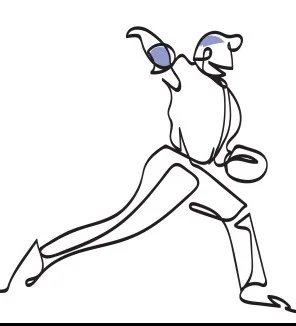Absolute Throwing; Part II.
The Temporal Approach for Pitch Design (Real Arm Speed)
In spite of injury rates on the rise and tolerance for throwing volume falling off a cliff, the fact remains- velocity wins. Today’s hitters bear witness to the nastiest 90-95 MPH sliders the game has ever seen. Velocity for the pitcher is universally accepted as the number one most important and commercially marketable quality for a pitcher to possess, and for good reason.
The practice of data-informed pitch design has measurably proven that aside from varying grip and angle of the arm at release, arm speed is the primary engine driving spin. It is the ability of a pitcher to manipulate ball spin that truly tips the scale towards the “king of the hill”. If the pitcher could only throw one pitch, or if the batter knew what was coming, we would see football scores daily.
Perhaps this explains why fans are subconsciously drawn to the sport. The dramatic mental battle for control between foes. More than ever, today’s best hitters need to assume a general pitch speed and shape in order to have a chance at being successful. This dynamic also explains the difference between the need for maximal velocity efforts on each pitch between the batter and pitcher. For the pitcher, assuming command, the more velocity the better, whereas the hitter must tempers effort in order to preserve accurate decision making.
All of this is to say that the development of arm speed as a tool (like bat speed) is the key to increasing potential advantage within the game. When applying Hyper Stride, protocols differ in the inclusion of the Extension Curl (bridge/hamstring) and Flexion Curl (rollout). These exercises are ordered in the middle and end of the Temporal Series to match the order in which the movement skills are expressed in the throwing delivery. Near the moment of front foot strike, the throwers begins to rotate the torso and arm into the “lay-back” position:
Achieving not only arm depth but mechanical tension in the lay back position is a major indicator of arm speed potential. The movement skills associated with developing healthy lay back are trained in the Extension and Flexion Curl, specifically the ability to control the rib cage during overhead shoulder flexion, upward rotation of the rotator cuff, and lead leg stability. In combination, these skills can lead to arm speed and to dynamic control of spinal (head still) mechanics.
The Integrated Approach for Perceived Velocity, and “tunneling”.
In 2019, I wrote about the “measurably imperative stride length”, explaining the importance of both distance and force of the throwers forward move. Another term that has emerged from the “pitch design tree” is tunneling. The pitcher’s ability to efficiently move down the mound allows for the transfer of force into the ball and reduces the space in which a batter can perceive the pitch flight. Today, technologies like 3D capture and force plates confirm the importance/influence of the stride with a combined data set that illustrates the relationship between stride length and force displacement. With this knowledge, a pitchers mechanics can be be instantly confirmed to be working with or against preferred style.
Athletes can be coached in and out of optimal mechanics, and can also do this all by themselves over the course of the season and career. The topic of “right time and place for the right coaching solution” is for another day.
With the Integrated Approach the pitcher’s stride can be optimized in real time, while upholding unique postural and force related characteristics of the athlete. The Lateral and Linear Strides act as a method for naturally bridging the dynamic change of direction experienced in the throwing delivery. When adjusted to Mode 4, the static platform, vertical forces can be trained in the same way they are expressed in throwing (static and semi-static). Another popular term to summarize this action is “organization”. By learning to anchor the torso with the lower half (ankle-knee-hip) in the lateral and linear axis independently, the athlete is free to express unique organization style without being coached.
When appropriately implemented, these exercises can replicate with analogous metrics/insights such as stride distance, magnitude of force and peak force impulse (additional crane scale required) before during and after throwing. Whether a mechanical characteristic is viewed as a flaw or style, the Integrated Approach can be used to regulate, recover and increase performance.
In the third and final entry in the Absolute Throwing series, I will illustrate how the 3 Approaches, along with previously published concepts, can be used to systematically assess and improve throwing performance.

